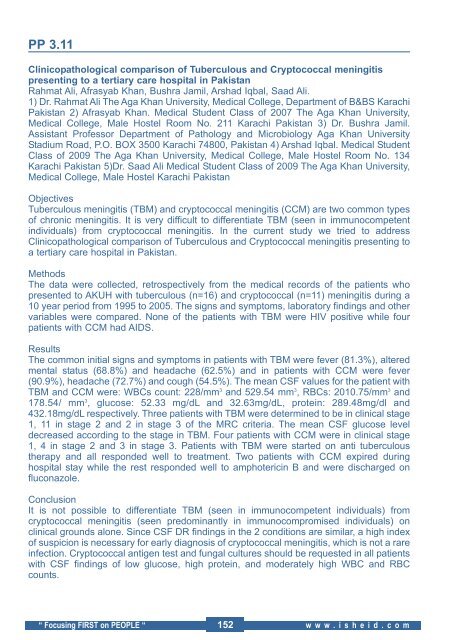final program.qxd - Parallels Plesk Panel
final program.qxd - Parallels Plesk Panel
final program.qxd - Parallels Plesk Panel
You also want an ePaper? Increase the reach of your titles
YUMPU automatically turns print PDFs into web optimized ePapers that Google loves.
PP 3.11<br />
Clinicopathological comparison of Tuberculous and Cryptococcal meningitis<br />
presenting to a tertiary care hospital in Pakistan<br />
Rahmat Ali, Afrasyab Khan, Bushra Jamil, Arshad Iqbal, Saad Ali.<br />
1) Dr. Rahmat Ali The Aga Khan University, Medical College, Department of B&BS Karachi<br />
Pakistan 2) Afrasyab Khan. Medical Student Class of 2007 The Aga Khan University,<br />
Medical College, Male Hostel Room No. 211 Karachi Pakistan 3) Dr. Bushra Jamil.<br />
Assistant Professor Department of Pathology and Microbiology Aga Khan University<br />
Stadium Road, P.O. BOX 3500 Karachi 74800, Pakistan 4) Arshad Iqbal. Medical Student<br />
Class of 2009 The Aga Khan University, Medical College, Male Hostel Room No. 134<br />
Karachi Pakistan 5)Dr. Saad Ali Medical Student Class of 2009 The Aga Khan University,<br />
Medical College, Male Hostel Karachi Pakistan<br />
Objectives<br />
Tuberculous meningitis (TBM) and cryptococcal meningitis (CCM) are two common types<br />
of chronic meningitis. It is very difficult to differentiate TBM (seen in immunocompetent<br />
individuals) from cryptococcal meningitis. In the current study we tried to address<br />
Clinicopathological comparison of Tuberculous and Cryptococcal meningitis presenting to<br />
a tertiary care hospital in Pakistan.<br />
Methods<br />
The data were collected, retrospectively from the medical records of the patients who<br />
presented to AKUH with tuberculous (n=16) and cryptococcal (n=11) meningitis during a<br />
10 year period from 1995 to 2005. The signs and symptoms, laboratory findings and other<br />
variables were compared. None of the patients with TBM were HIV positive while four<br />
patients with CCM had AIDS.<br />
Results<br />
The common initial signs and symptoms in patients with TBM were fever (81.3%), altered<br />
mental status (68.8%) and headache (62.5%) and in patients with CCM were fever<br />
(90.9%), headache (72.7%) and cough (54.5%). The mean CSF values for the patient with<br />
TBM and CCM were: WBCs count: 228/mm 3 and 529.54 mm 3 , RBCs: 2010.75/mm 3 and<br />
178.54/ mm 3 , glucose: 52.33 mg/dL and 32.63mg/dL, protein: 289.48mg/dl and<br />
432.18mg/dL respectively. Three patients with TBM were determined to be in clinical stage<br />
1, 11 in stage 2 and 2 in stage 3 of the MRC criteria. The mean CSF glucose level<br />
decreased according to the stage in TBM. Four patients with CCM were in clinical stage<br />
1, 4 in stage 2 and 3 in stage 3. Patients with TBM were started on anti tuberculous<br />
therapy and all responded well to treatment. Two patients with CCM expired during<br />
hospital stay while the rest responded well to amphotericin B and were discharged on<br />
fluconazole.<br />
Conclusion<br />
It is not possible to differentiate TBM (seen in immunocompetent individuals) from<br />
cryptococcal meningitis (seen predominantly in immunocompromised individuals) on<br />
clinical grounds alone. Since CSF DR findings in the 2 conditions are similar, a high index<br />
of suspicion is necessary for early diagnosis of cryptococcal meningitis, which is not a rare<br />
infection. Cryptococcal antigen test and fungal cultures should be requested in all patients<br />
with CSF findings of low glucose, high protein, and moderately high WBC and RBC<br />
counts.<br />
“ Focusing FIRST on PEOPLE “ 152 w w w . i s h e i d . c o m
















